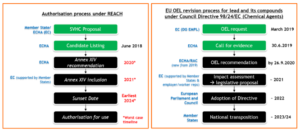Lead-free Transition for the European Space Sector
- Posted by Agustin Coello
- On November 18, 2019
- 0
The European Space Sector can no longer avoid the need to plan and implement a managed transition to lead-free electronics. This stimulus comes from two fronts:
- Regulatory front
- Market pressures
Regulatory Front
In the Regulatory front while equipment designed to be sent into space is explicitly out of scope of the RoHS Directive, a new front has recently opened with REACH. Lead (Pb) has now been included it in the REACH Candidate List of SVHC for Authorisation (June 2018).
At the same time the EC has initiated a review of lead in the frame of the EU OSH (Occupational Safety and Health legislation). In January 2019 ECHA was requested by EC DG EMPL to update the existing health-based bOEL (air) and biological limit value (blood) for lead and its compounds under the Chemical Agents Directive (CAD). The updating under OSH could have a deprioritisation effect for lead under REACH (authorisation process).

Today we cannot preclude the final outcome of the process, it could be either complying with OEL requirements at the workplace only or also to resort to Requests for Authorisation
Market Pressures
- Due to the overall transition of the Electronics Industry worldwide to a Pb-free realm, the Space Industry is more and more confronted with a situation where they cannot avoid using EEE parts with Pb-free coatings and they need to manage the associated risks.
- The growing use of commercial components (COTS), notably for the expanding market sector of constellations, means that European Space Industry is already using large amount of components with lead-free terminations even when the equivalent leaded high-rel version is available.
- Market pressure may also result on potential future difficult availability of leaded solder paste
- In order to prepare for that future risk, the European Space Industry will need to introduce lead-free soldering processes, an extensive and very expensive undertaking for the European space Industry
- Changing to lead-free soldering is not required for massive COTS introduction
SCSB Decision
- Taking into account of all these, in 2019 the SCSB agreed to launch a joint task force consisting of MPTB and CTB members to:
In the domain of EEE components, electronic assembly technologies and PCBs, ensure a successful industry-wide transition to a Pb-free technology while preserving or improving current levels of quality and reliability
Task Force Composition
- ESA
- CNES
- DLR
- UKSA
- ADS
- ARIANEGROUP
- CTB Chairman
- TAS
- ALTER
- RUAG
- ReachLaw
- MPTB Chairman
- Continental (Observer)
Main Preliminary Conclusions COTS use:
- There is enough data on the reliability of SnPb solder joints (other than Tin-whisker risk) for all lead-free terminations of EEE parts (COTS and others) that the Space Sector currently use or wish to use.
- The only action required is to modify the applicable European standards to allow the use of those EEE parts with lead-free terminations
- Tin-whisker risk can be adequately managed using existing North-American GEIA and JESD standards. However the Task Force is of the opinion that a European version for those standards is desirable.
Main Preliminary Conclusions Soldering:
- Concerning the timing to change the soldering processes to eliminate lead:
-
- In the short term (< 5 years) : no risk associated with Regulation or obsolescence of SnPb solder
-
- Medium term (< 10 years) : no risk from Regulation and very low risk associated with SnPb solder obsolescence
-
- Long term (> 10 years) : very low risk from the Regulatory side and potential risk associated with SnPb materials obsolescence.
- If someone wishes to go to lead-free soldering in the short term, reliability data available for SAC 305 make it possible to change today. For those that can wait, other, probably better, lead-free solders are being developped
Next Steps
- The Task Force should deliver a Roadmap for Lead-free Transition at the end of the year
- Lead-free Transition for the European Space Sector - November 18, 2019


0 comments on Lead-free Transition for the European Space Sector